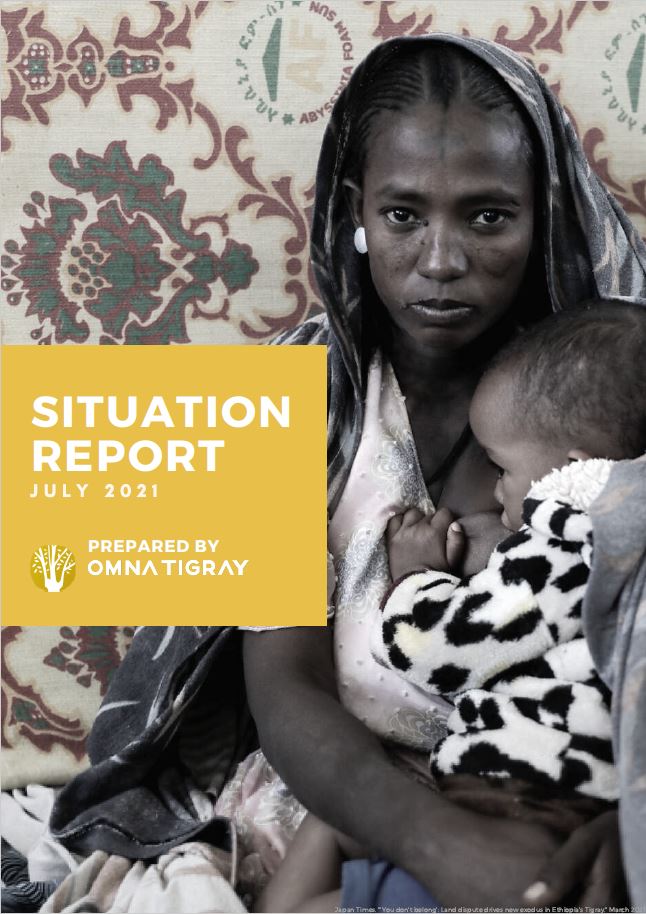OMNA TIGRAY – FEBRUARY 2025 QUARTERLY SITUATION REPORT


Since the official declaration of war on November 4, 2020, the Ethiopian National Defense Forces (ENDF), Eritrean Defense Forces (EDF), and Amhara forces have wreaked havoc in Tigray, committing atrocities that amount to war crimes, crimes against humanity, and acts of genocide. This brutal war has caused immense human suffering with countless reports of massacres and extrajudicial executions, widespread weaponized Sexual and Gender-Based Violence (SGBV), a man-made famine, and a refugee crisis that has displaced millions.
In addition to the massacres carried out in Axum, Maryam Dengelat, and Kola Tembien in which hundreds of civilians were killed by Ethiopian and Eritrean forces, new video evidence of the January Mahbere Dego massacres surfaced in July. These extremely graphic videos show the ENDF grouping unarmed civilians by a cliff edge, executing and throwing their bodies over the cliff. A June 16 letter written by the interim administration of the Mai Kinetal zone in Central Tigray revealed that 440 people have been killed, 558 people have been victims of SGBV, and 125 people had died of starvation in this small region alone. Finally, an aerial bombardment on June 22 by the Ethiopian Air Force of the market town of Togoga, which is located 25 kilometers from Mekelle, killed over 60 civilians and injured hundreds. This Togoga Market airstrike took place around noon, with as many as 3,000 civilians trading goods on a busy market day. In an effort to maximize casualties, Ethiopian forces also blocked ambulances that were attempting to reach Togoga to help survivors.
As we continue to receive more reports of the atrocities committed in Tigray, the number of reported cases of SGBV, including rape and gang-rape is steeply rising. While over 500 cases of SGBV had been officially reported in May 2021, there were over 120 cases reported during the first week of June alone. As the United States Agency for International Development (USAID) reported, at least 22,500 women and girls in Tigray will seek medical help for SGBV in 2021. Due to the systematic destruction of health facilities, road blockades in the region, and the psychological trauma around SGBV, we know that reporting is hindered and this is a very conservative estimate. It is suspected that the actual number of women and girls who have endured SGBV is much higher. Finally, the man-made famine that has gripped the region will likely kill tens of thousands, unless corrective measures are taken immediately. The USAID revealed at the end of June that the number of people living in famine conditions in Tigray had grown exponentially, rising to a staggering 900,000 people. Of these, at least 33,000 are children, who are at high risk of acute malnutrition and famine.
On June 28, the ENDF began an abrupt withdrawal from Tigray’s capital city of Mekelle and many other parts of Tigray, after suffering military defeat at the hands of the Tigray Defense Forces (TDF). Despite announcing what it has claimed to be a unilateral ceasefire, the Abiy Administration has stated that it has the power and ability to return to Tigray to continue committing atrocities and brutalizing the people. The ENDF reportedly emptied out banks, looted public and private property, and destroyed crucial infrastructure on their way out of Mekelle. Most notably, ENDF forces dismantled satellite equipment in UNICEF’s offices in Mekelle, in violation of international humanitarian law.
Moreover, the Abiy Administration imposed a telecommunications, transportation, and banking blockade in Tigray, exacerbating the insecurity of millions of people and worsening the humanitarian crisis. In addition, three days after the ceasefire on July 1, Amhara Regional Special Forces destroyed the bridge over the Tekeze River, which connects Gondar (Amhara) to Shire (Northwestern Tigray). The Tekeze bridge was one of the main supply routes for transferring aid to Western Tigray. According to Rashid Abdi, a Horn of Africa analyst, 60 percent of aid traffic goes through the Tekeze Bridge. The
destruction of the bridge is part of the Ethiopian government’s strategy to starve and isolate Tigray. Now that Tigray’s legitimately elected government has taken back control of many parts of Tigray, a full restoration of all essential services and unhindered humanitarian access by the federal government is required to ensure that thousands of people in Tigray do not die from the famine engineered by Abiy Ahmed of Ethiopia and Isaias Afewerki of Eritrea.
Finally, in a war that has unleashed incomprehensible brutalities time and again, in June, humanitarian workers who have dedicated their lives to helping civilians were brutally attacked. OMNA Tigray has put out a press release (accessible here), but would like to reiterate its heartfelt condolences to the families of Maria Hernandez, Yohannes Halefom Reda, and Tedros Gebremariam Gebremichael, who were killed while trying to provide aid to communities in dire need of assistance. In addition to Hernandez, Yohannes, and Tedros, at least 10 other humanitarian workers have tragically lost their lives in Tigray. Instead of ensuring their safety and security, in a televised June 23 interview, Abiy attacked and demonized humanitarian workers, which exposes workers on the ground to more danger. The harassment, attacks, and killing of humanitarian workers is part and parcel of the overall strategy of brutalizing and starving the people of Tigray, by scaring off the people who are best placed to provide relief. We condemn attacks against humanitarian workers in the strongest terms and call on international actors to ensure their protection, working in concert with the restored government of Tigray and the TDF.